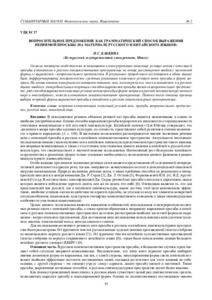Please use this identifier to cite or link to this item:
https://elib.psu.by/handle/123456789/30001Full metadata record
| DC Field | Value | Language |
|---|---|---|
| dc.contributor.author | Бабкина, П. С. | - |
| dc.contributor.author | Babkina, P. | - |
| dc.date.accessioned | 2022-03-03T07:20:24Z | - |
| dc.date.available | 2022-03-03T07:20:24Z | - |
| dc.date.issued | 2022 | - |
| dc.identifier.citation | Бабкина, П. С. Вопросительное предложение как грамматический способ выражения непрямой просьбы (на материале русского и китайского языков) / П. С. Бабкина // Вестник Полоцкого государственного университета. Серия A, Гуманитарные науки. - 2022. - № 2. - С. 55-61. | ru_RU |
| dc.identifier.issn | 2070-1608 | - |
| dc.identifier.uri | https://elib.psu.by/handle/123456789/30001 | - |
| dc.description.abstract | Статья посвящена особенностям использования и интерпретации косвенных речевых актов с интенцией просьбы в китайском и русском лингвокогнитивном пространстве на основе рассмотрения наиболее частотной формы ее выражения – вопросительного предложения. В результате проведенного исследования в обоих языках были дифференцированы лингвистические средства реализации косвенного речевого акта просьбы в форме вопроса. На основе анализа материала исследования показано, что, несмотря на то, что и в китайском, и в русском языках наиболее употребительным непрямым способом выражения просьбы является вопросительное предложение, ряд способов выражения косвенных речевых актов просьбы в форме вопроса в русской лингвокультуре намного шире и многообразнее, нежели в китайском лингвокогнитивном пространстве. Помимо этого описаны причины выбора непрямой формы выражения просьбы в китайском и русском социокультурных пространствах.= The article is devoted to the peculiarities of the use and interpretation of indirect speech acts with the intention of request in the Chinese and Russian linguistic and cognitive space based on the consideration of the most frequency form of its expressing – an interrogative sentence. As a result of the study the linguistic means of implementing the indirect speech act of request in the form of question were differentiated in both languages. Based on the analysis of the research material, it is shown that, despite the fact that both in Chinese and in Russian the most common indirect way of expressing request is an interrogative sentence, the number of ways of expressing indirect speech acts of request in the form of question in the Russian linguistic and cultural space much wider and more diverse rather than in the Chinese linguistic and cognitive space. In addition, the reasons for choosing an indirect form of expressing request in the Chinese and Russian social and cultural space are described. | ru_RU |
| dc.language.iso | ru | ru_RU |
| dc.publisher | Полоцкий государственный университет | ru_RU |
| dc.relation.ispartof | Веснік Полацкага дзяржаўнага ўніверсітэта. Серыя А, Гуманітарныя навук | be_BE |
| dc.relation.ispartof | Herald of Polotsk State University Series A, Humanity sciences | en_EN |
| dc.relation.ispartof | Вестник Полоцкого государственного университета. Серия A, Гуманитарные науки | ru_RU |
| dc.relation.ispartofseries | Серия A, Гуманитарные науки;2022. - № 2 | - |
| dc.rights | open access | ru_RU |
| dc.title | Вопросительное предложение как грамматический способ выражения непрямой просьбы (на материале русского и китайского языков) | ru_RU |
| dc.title.alternative | Interrogative Sentence as a Grammatic Way of Expressing an Indirect Request (On the Material of the Russian and Chinese Languages) | ru_RU |
| dc.type | Article | ru_RU |
| dc.identifier.udc | 81`27 | - |
| Appears in Collections: | 2022, № 2 | |
Items in DSpace are protected by copyright, with all rights reserved, unless otherwise indicated.
